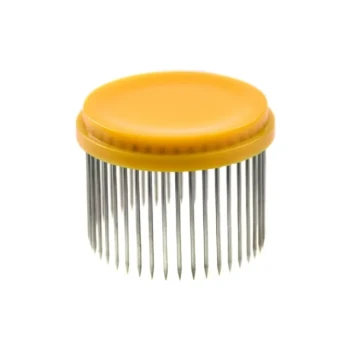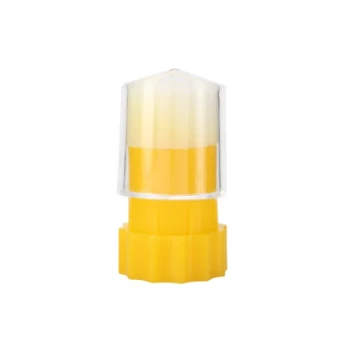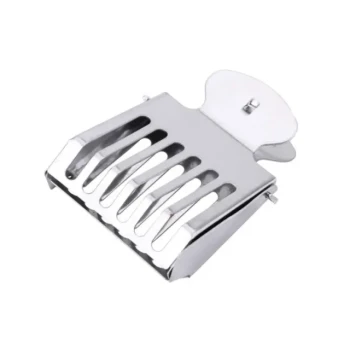To put it simply, future queen bees develop in specially constructed, oversized cells that hang vertically from the honeycomb. Unlike the thousands of hexagonal cells used for workers and drones, these unique structures, known as queen cells, are built specifically for the purpose of raising a new queen.
The existence of a queen cell is more than just a difference in architecture; it signals a critical moment in the life of a honeybee colony, indicating a plan to replace the current queen or swarm to form a new colony.
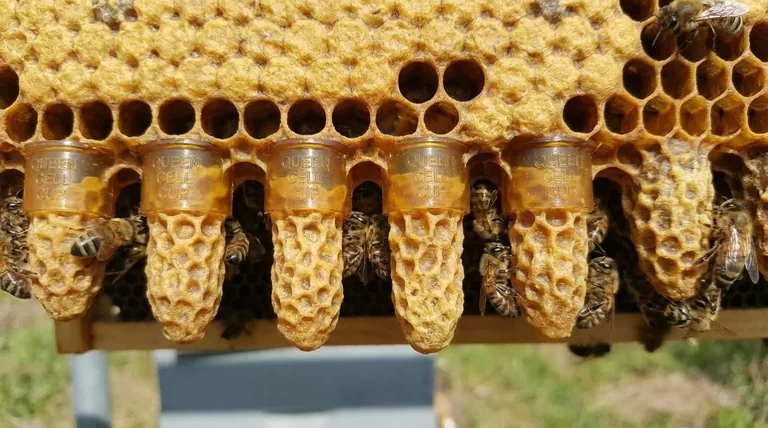
The Anatomy of a Queen Cell
A queen cell is one of the most distinct and easily recognizable features within a beehive. Its unique design is entirely functional, built to accommodate the development of the largest and most important bee in the colony.
A Vertical Orientation
The most defining characteristic of a queen cell is its orientation. While worker and drone cells are built horizontally into the main structure of the comb, queen cells hang vertically, typically pointing downwards. This provides ample space for the queen larva, which is significantly larger than a worker larva, to grow.
Peanut-Like Shape and Texture
Queen cells are often described as looking like a peanut shell in both shape and texture. They are roughly cylindrical, dimpled, and much larger than any other cell in the hive. This unique appearance makes them stand out immediately during a hive inspection.
Location on the Comb
Bees build queen cells in specific locations depending on their purpose. They are often found on the face of the comb or, more commonly, along the bottom edges of the frames. Their placement is not random; it is a deliberate choice made by the colony.
Why a Special Cell is Necessary
The creation of a queen cell is the colony's first step in a biological process that fundamentally separates a queen from a worker bee. The cell itself is an incubator for a completely different developmental path.
The Deciding Factor: Diet
A honeybee larva's destiny is determined by its diet. A larva destined to become a worker is fed royal jelly for only the first three days before being switched to a diet of "bee bread" (pollen and honey). A larva in a queen cell, however, is fed an exclusive diet of royal jelly throughout its entire development.
Accommodating Queen Development
The queen cell's large size is necessary to house the growing larva and the massive quantity of royal jelly it consumes. This protein-rich diet is what triggers the full development of her reproductive organs, turning a genetically identical larva into a queen instead of a sterile worker.
What Queen Cells Signal
The presence and type of queen cells are one of the most important indicators of a colony's status and future intentions. A beekeeper learns to "read" these cells to understand what is happening inside the hive.
Swarm Cells
These cells are built in preparation for swarming, the natural method of colony reproduction. A strong, populous colony will build multiple swarm cells, often 10 or more, typically along the bottom of the frames. This is a sign of a healthy, growing colony that is preparing to split.
Supersedure Cells
When a colony decides its current queen is failing—perhaps due to age, injury, or poor egg-laying—it will build supersedure cells to raise a replacement. Usually, only a few (1-3) are made, and they can be located on the face of the comb. This is the colony's way of ensuring a smooth transition of power.
Emergency Cells
If a queen is suddenly killed or lost, the colony will go into an emergency response. The bees will select several existing worker larvae that are young enough (under three days old) and modify their horizontal cells to become queen cells. These emergency cells are a sign of a sudden, queenless crisis.
Making the Right Choice for Your Goal
Interpreting the presence of queen cells is a critical skill for any beekeeper, as the correct response depends entirely on the context and your specific objectives.
- If your primary focus is preventing swarming: The appearance of multiple swarm cells is your cue to intervene, typically by splitting the colony to relieve congestion.
- If your primary focus is colony health: Finding one or two supersedure cells is often a positive sign that the bees are proactively managing their own leadership without your help.
- If your primary focus is saving a queenless hive: Spotting emergency cells confirms the colony is trying to save itself, and you must decide whether to let them raise their own queen or introduce a new one.
Ultimately, a queen cell is the physical manifestation of a colony's plan for the future.
Summary Table:
| Type of Queen Cell | Purpose | Typical Number & Location | What It Signals |
|---|---|---|---|
| Swarm Cells | Colony reproduction (swarming) | Many (10+), along bottom edges | A healthy, populous colony preparing to split |
| Supersedure Cells | Replacing a failing queen | Few (1-3), on the comb's face | Proactive management of a failing queen |
| Emergency Cells | Responding to sudden queen loss | Several, modified from worker cells | A queenless crisis; colony is trying to recover |
Master the art of reading your hive's most important signals.
Understanding queen cells is essential for managing colony health and productivity. Whether your goal is to prevent swarming, support a supersedure, or save a queenless hive, having the right equipment is the first step.
HONESTBEE supplies commercial apiaries and beekeeping equipment distributors with the durable, wholesale-focused supplies needed to support strong colonies. From hive tools for careful inspections to frames that accommodate natural comb building, we provide the foundation for successful beekeeping.
Ready to equip your operation for success? Contact our team today to discuss your wholesale needs.
Visual Guide
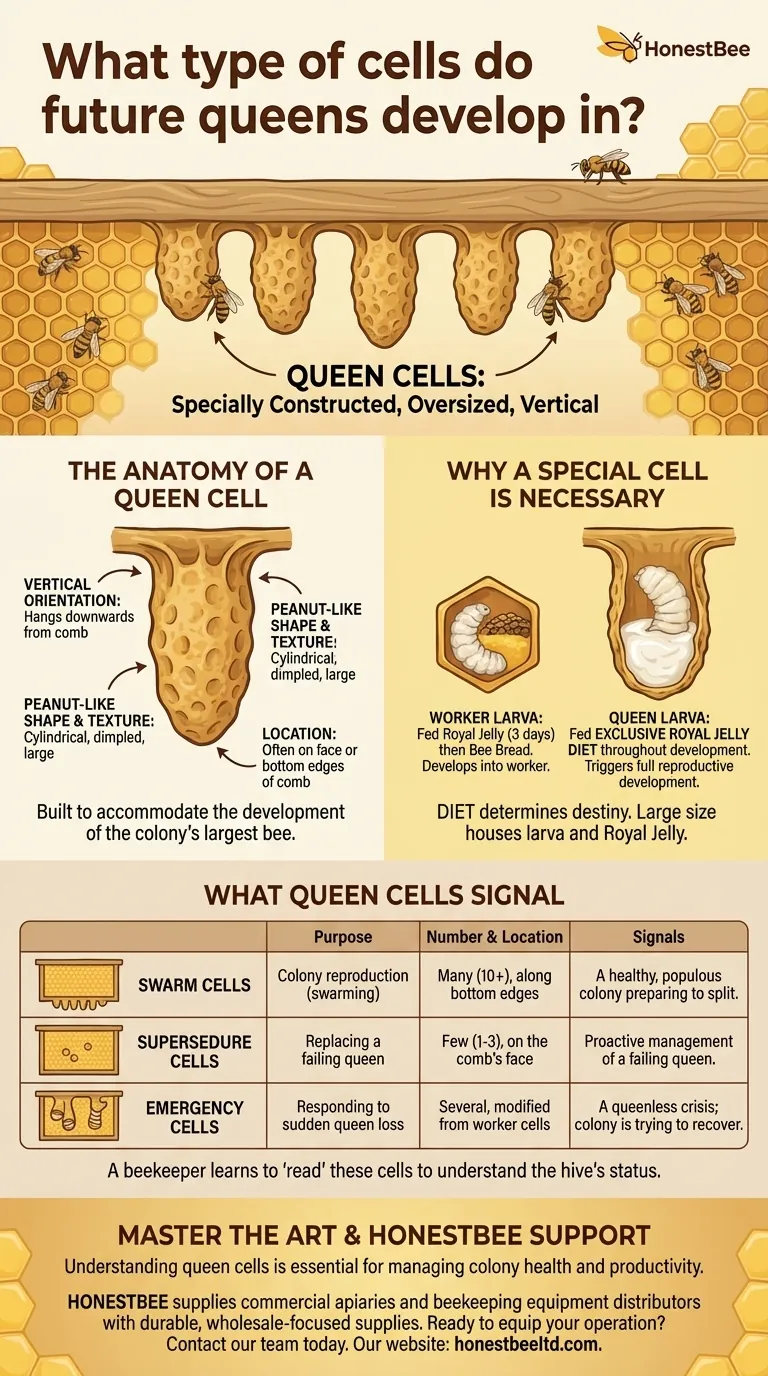
Related Products
- Brown Nicot Queen Cell Cups for Breeding Queen Bees Beekeeping
- JZBZ Push-In Queen Cell Cups for Beekeeping
- Clear Black Plain Polystyrene Queen Bee Grafting Cell Cups No Lug for Bee Queen Cup
- Plastic Chinese Queen Grafting Tool for Bee Queen Rearing
- Stainless Steel Queen Grafting Tool for Beekeeping and Bee Queen Grafting
People Also Ask
- What is the advantage of the Nicot Cupkit system? Secure Your Queen Rearing Success with Batch Protection
- What role does the natural swarming process play in queen rearing? Harness the Swarm Instinct for Better Queens
- How are the queen cells raised after removing the plugs? Master the Art of Queen Rearing
- How does Queen Rearing with JZBZ work? A Reliable System for Consistent Queen Production
- How many cells are given to a nucleus? Understand the One-to-One Rule in Cell Biology







